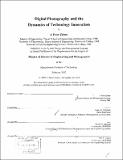Digital photography and the dynamics of technology innovation
Author(s)
Zelten, J. Peter
DownloadFull printable version (12.32Mb)
Other Contributors
System Design and Management Program.
Advisor
James M. Utterback.
Terms of use
Metadata
Show full item recordAbstract
Companies heavily and successfully invested in traditional technologies (defenders) often find it difficult to make the transitions to new disruptive technologies, in spite of technological competence and clear opportunity to do so. The core competencies that enabled the firm to excel under the old paradigms become core rigidities when faced with the need to address technological discontinuities. Products like digital still cameras, DSCs, represent the convergence of multiple rapidly changing technologies in electronics, optics, computers, networks, and software. The emergence and adoption of digital still photography both accompanies and defines a new paradigm in the sharing of images as it attempts to both emulate and replace the previous modalities while creating new market-expanding opportunities. The emergence of digital still photography has been predicted and promised for several decades. Indeed, it has already managed to replace silver halide altogether in certain market segments previously relied upon by conventional photography firms, and is at present extending beyond the early adopter stage in the broader consumer market. It is a current example of innovation and technological discontinuity, and one that has enough history to permit analysis. It poses a real potential disruptive threat to the incumbent players, some of which have succumbed while others apparently succeeded. This thesis studies the relationships between the development of the composite technologies in digital photography, the environment in which they operate, the emergence of dominant designs, market diffusion, and the strategies for success employed by leading participants. In the process of studying patterns of entry and exit firms and a detailed look at their products, evidence of a dominant design and support in this industry for the Abernathy and Utterback model of industrial innovation is uncovered. Also revealed is a second wave of innovation in the DSC industry that is firmly established and suggests the onset of a Christiansen-style disruptive dynamic. By studying this specific technological discontinuity in the context of the broader patterns, lessons in adapting to technological change in general are learned.
Description
Thesis (S.M.)--Massachusetts Institute of Technology, System Design & Management Program, 2002. Includes bibliographical references (leaf 96).
Date issued
2002Department
System Design and Management Program.Publisher
Massachusetts Institute of Technology
Keywords
System Design and Management Program.